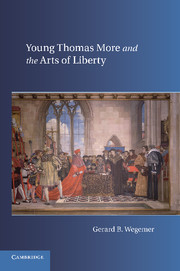Book contents
- Frontmatter
- Contents
- List of Illustrations
- Acknowledgments
- List of Abbreviations
- 1 Young Thomas More
- 2 Fashioning Peace and Prosperity
- 3 Cicero's and More's First Citizens
- 4 More's Earliest Views of Humanitas, Libertas, and Respublica, 1500–1506
- 5 More's Life of Pico della Mirandola (c. 1504–1507)
- 6 More's 1509 Coronation Ode
- 7 Political Poems of 1509–1516
- 8 Richard III
- 9 Utopia
- 10 The Un-Utopian Thomas More Family Portrait
- 11 The Arts of Liberty
- Works Cited
- Index
10 - The Un-Utopian Thomas More Family Portrait
An Icon of Morean Humanitas?
Published online by Cambridge University Press: 25 October 2011
- Frontmatter
- Contents
- List of Illustrations
- Acknowledgments
- List of Abbreviations
- 1 Young Thomas More
- 2 Fashioning Peace and Prosperity
- 3 Cicero's and More's First Citizens
- 4 More's Earliest Views of Humanitas, Libertas, and Respublica, 1500–1506
- 5 More's Life of Pico della Mirandola (c. 1504–1507)
- 6 More's 1509 Coronation Ode
- 7 Political Poems of 1509–1516
- 8 Richard III
- 9 Utopia
- 10 The Un-Utopian Thomas More Family Portrait
- 11 The Arts of Liberty
- Works Cited
- Index
Summary
[T]he lad, while mad, sought the stars, trusting in new arts, and strove to vanquish true birds in flight, demanding too much of his false wings ….
Were it mine to fashion [fingere] fate at my will, I would trim my sails to gentle winds, lest my yards tremble, bent 'neath a heavy blast a gentle, moderate breeze that does not heel the side would guide my untroubled boat.
Texts from Seneca that appear in the Thomas More family portraitThe elegant dress of this wealthy family depicted in the portrait Sir Thomas More and His Family stands in sharp contrast to the simple unfinished clothes mandated in Utopia. Most striking are old Judge More's bright scarlet robes of office, which remind us that Utopia has no judiciary separate from its senate and princeps. Sir Thomas's gold chain and red-velvet sleeves put him in the company of those Anemolian ambassadors ridiculed by Utopian children, as would the gold jewelry and beautiful attire accented with gold brocade of More's wife and daughters. The humor represented by the family monkey and the professional “fool” in the painting have no parallels in humorless Utopia.
More's secretary, John Harris, stands in the doorway with an official document in hand, reminding us that Utopia does not have the secretarial trade, but it does have slaves.
The beautiful tapestry on the table and the rich gold and green draperies on the wall represent other trades excluded from Utopia, along with the craftsmen of the newfangled clock or the fine woodcarving seen in this portrait.
- Type
- Chapter
- Information
- Young Thomas More and the Arts of Liberty , pp. 160 - 175Publisher: Cambridge University PressPrint publication year: 2011



